Welcome to our new article on LiveOps in Hidden Object Games (HOGs), a part of the ‘How to set up LiveOps’ series, where we deconstruct genre-defining games.
This piece is devoted to the #1 top-grossing game in the HOG category – June’s Journey by Wooga. We will deconstruct its LiveOps strategy, which keeps players engaged throughout the years and contributes to the game’s ongoing success.
As always, we will also illustrate how June’s Journey LiveOps would look like if developers used the Balancy platform. Without further ado, let’s get started!
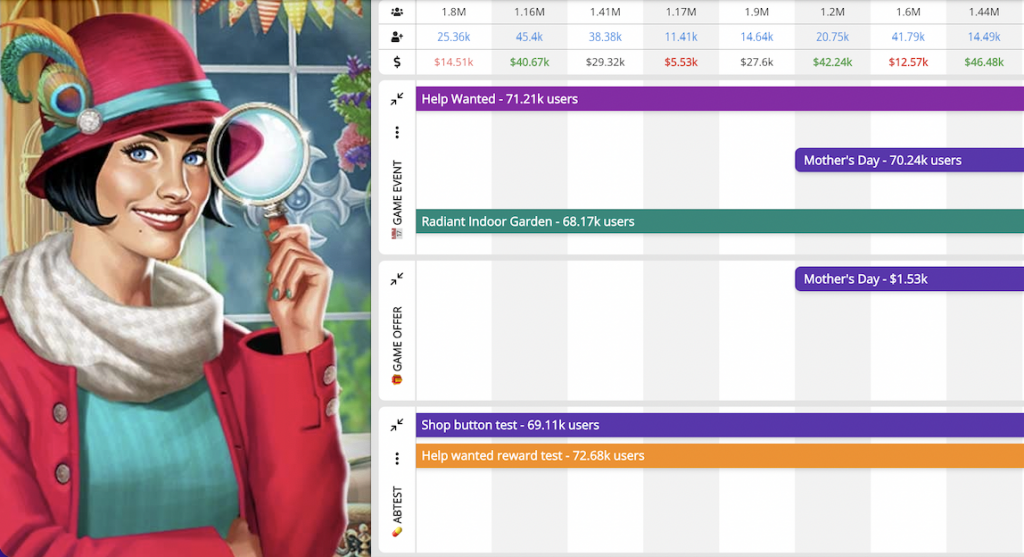
If you’ve missed our previous articles in this deconstruction series, check the article about Merge Mansion here.
Why June’s Journey?
June’s Journey has seen continuous revenue growth ever since its launch, making it a notable success in the gaming industry. The game was launched in 2017, but in May 2023, it peaked in revenue by earning 16 million $ in one month. The game is also the #1 top-grossing title in the Hidden Objects subgenre.

The revenue chart of June’s Journey from 2017 to 2023. The data is provided by AppMagic.
The reason behind a long-lasting success is a smart live operations strategy, which manages to keep players entertained with relevant content given at the right time: beautiful decorations, engaging events and tasks, new characters, and story twists…
During these six years, the game has grown immensely in content, and it provides quite different experiences for players at different life cycle stages. This article will cover the key elements available for most players during their first weeks in the game.
Gameplay Overview
June’s Journey is a Hidden Object Game (HOG) where players embark on a detective journey, searching for hidden objects to unlock story clues. The core mechanic revolves around finding hidden items within beautifully crafted scenes. To access new scenes and, hence, to progress through the detective story, players have to pay with energy ⚡.

In addition to the detective story and core HOG mechanic, June’s Journey features a world-building meta-layer. It is a classic garden decoration example: in Orchid Island, players decorate territory by purchasing various design elements using in-game currencies (coins🪙 and diamonds💎). This gives players an additional sense of progression and customization as they enhance their surroundings:
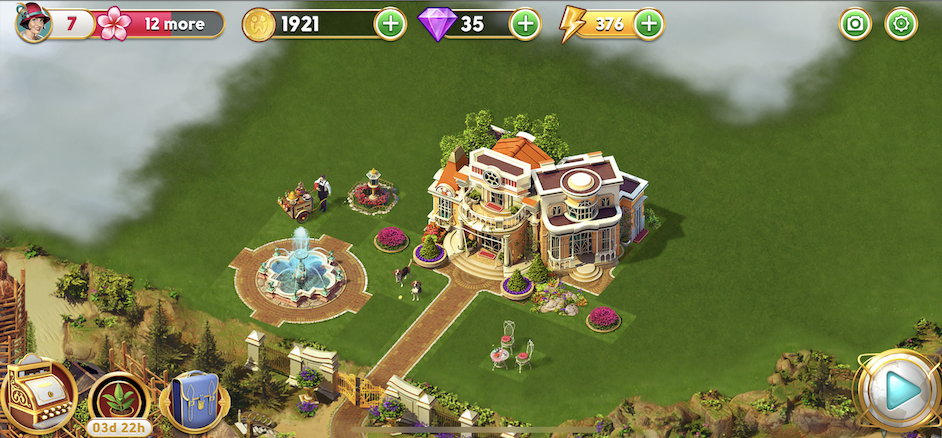
June’s Journey LiveOps (+Balancy examples)
1. The in-game shop
We can define two in-game shops available for players:
1. One of them is a traditional shop where players buy game resources: coins, diamonds, star boxes (for real money), and energy (for diamonds). Wooga’s team isn’t very generous with giving away resources, so players face the need to go to the shop from the very early steps in the game.
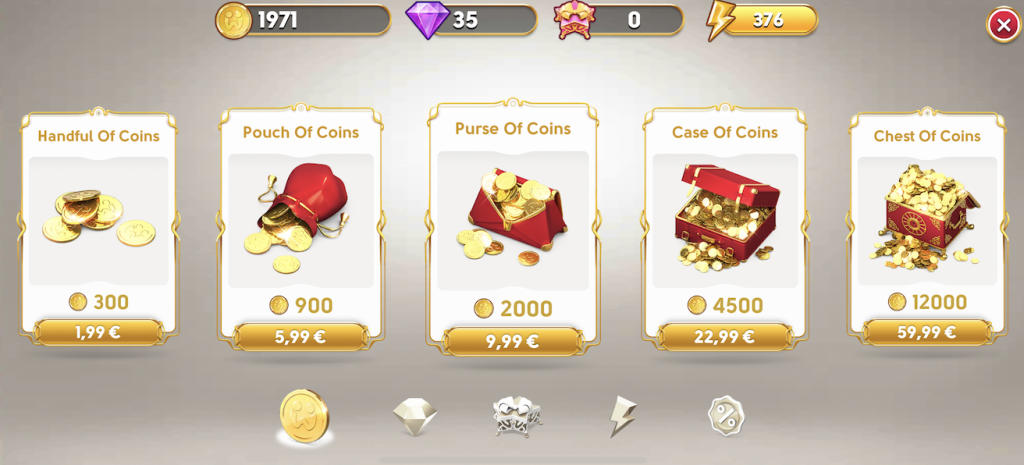
2. The second game shop offers a variety of garden decorations. You can buy these decorations by using virtual currencies – coins and diamonds. The first three sections of the shop offer permanent garden decorations available at any time (once unlocked). The fourth section features temporary event decorations that grant players event points after making a purchase. The last section of the shop is devoted to time-limited offers, where exclusive decorations are available for a limited time:

Balancy allows you to implement several shops in your game with multiple pages for various types of content. You can quickly adjust the shop’s content according to seasonal events and planned special deals, as well as change the display of times to different segments of players for a tailored shopping experience.
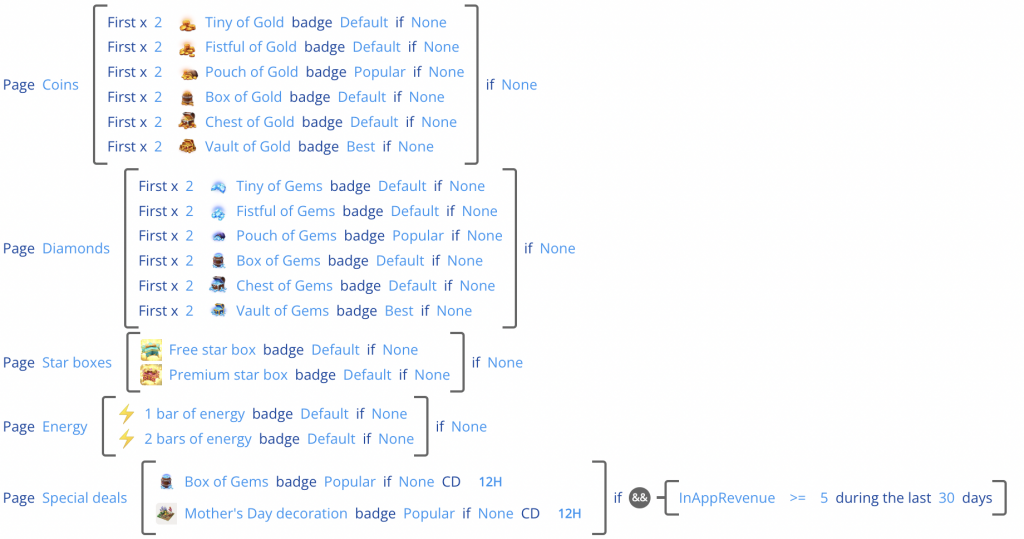
The implementation of an in-game shop, similar to June’s Journey, in Balancy.
2. Events with unique garden decorations (Seasonal Sets)
June’s Journey features regular events with unique themes and sets of decorations, such as the ‘Radiant Indoor Garden’ or ‘Elegant Gazebo’, to name a few. These events are available for a limited time and offer players an opportunity to acquire a grand prize. To obtain the grand prize, players purchase decorations from a special in-game store section, earning event points that accumulate toward the prize:
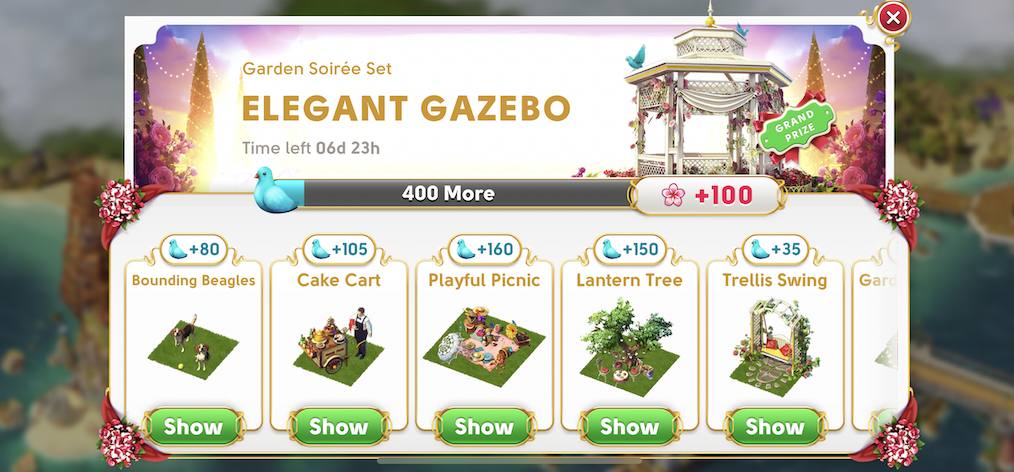
You can use Balancy to launch events like this one and specify conditions regarding who and when will access the event. In this case, the event will be available for everyone who launches the game on particular dates. But you can additionally specify more conditions, such as player level, country, or IAP history.

Implementation of the ‘Elegant Gazebo’ event in Balancy.
3. Time-limited special offers
Sometimes the June’s Journey team launches promotional sales, such as a recent one dedicated to Mother’s Day. In this example, players were shown a pop-up banner offering them to purchase a bundle of coins, decorations, and diamonds at a great discount of 55%:
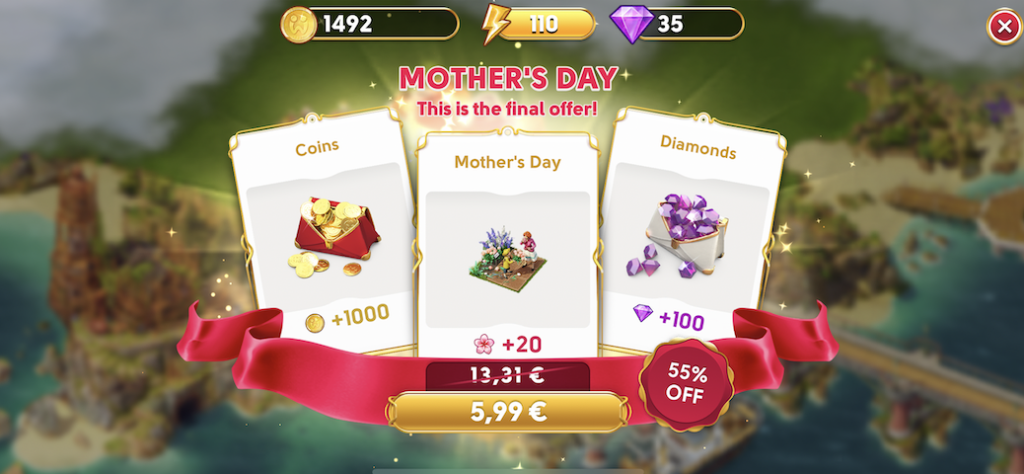
Here is how this offer implementation would look in Balancy. No coding and JSONs – you only need to fill in an offer template with the content of your choice: picture, description, and store item. Additionally, you can set a timer for the event duration and specify how many times this offer can be purchased. If you need to add more parameters to this offer, don’t worry, this template is totally customizable:

Interesting note: if players decline the offer, the banner doesn’t disappear immediately. Players are given another chance to reconsider:
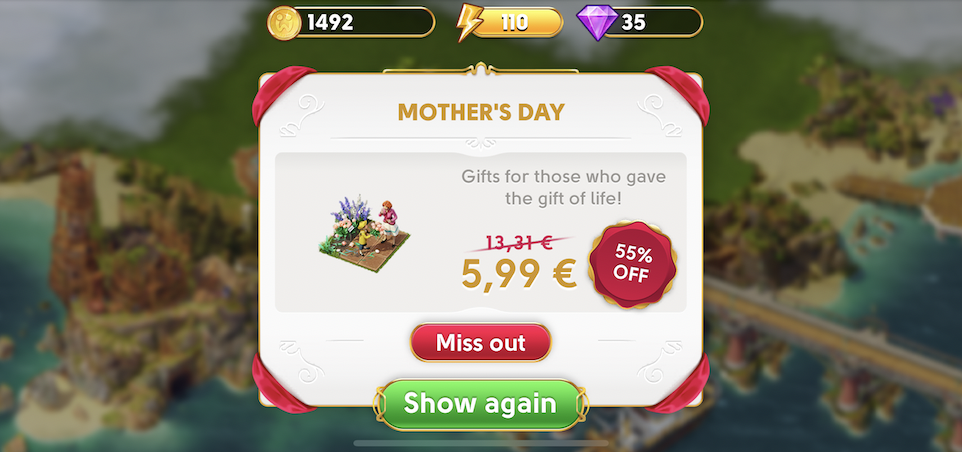
4. Daily rewards from a milkman
The game motivates players to log in daily by offering free daily deliveries from a milkman. In these deliveries, players get some rewards, such as game currencies and useful resources. Players who visit the game for 30 days will receive a special prize. This tactic encourages long-term retention:

This is an interface for setting up daily rewards in Balancy:

5. Star Boxes: free and premium
Star boxes are essentially loot boxes that contain various resources and items players may need in the game: energy, diamonds, coins, decorations, and materials. The element of surprise in the lottery-like star boxes adds excitement and anticipation for players.
The game occasionally offers free star boxes to create a sense of receiving gifts, which may entice players to consider purchasing premium 5-Star Boxes:
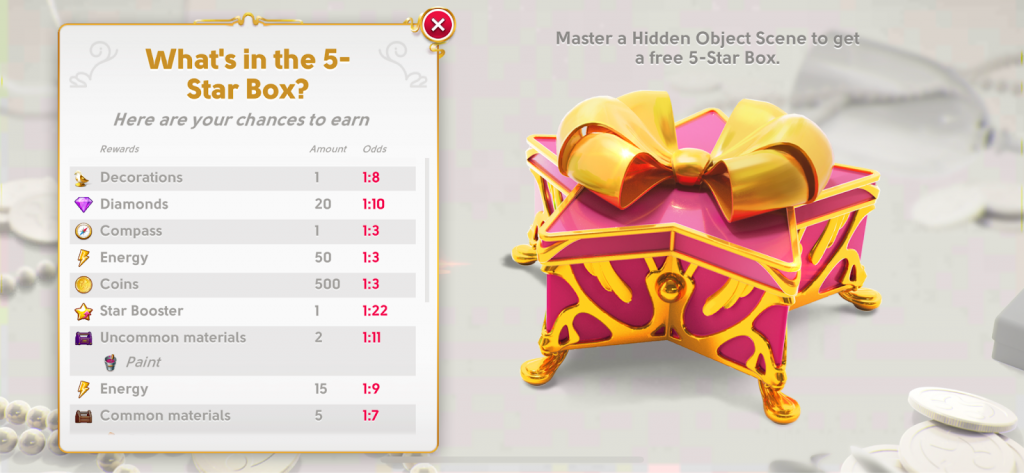
6. Well-integrated ad monetization
June’s Journey employs a clever strategy to generate additional revenue from non-paying players by finding good ad placements in the game. Here is one of the examples.
To play HOG scenes, players require energy. Playing multiple scenes in a row depletes energy quickly, but players can watch an advertisement to play scenes for only 10 energy points instead of 15 for the next 30 minutes. Not only it prompts players to watch ads, but it also prolongs the game session time:
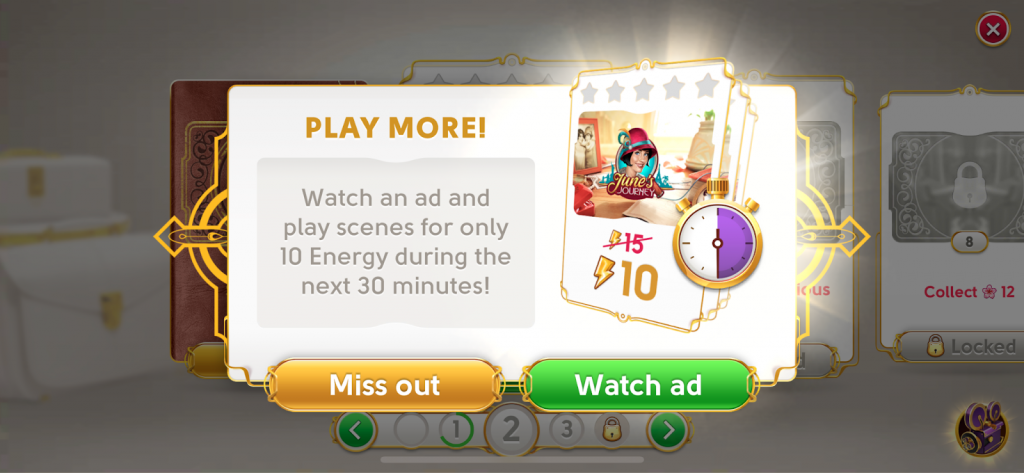
7. Challenges: ‘Help Wanted’ cases
After completing Chapter 4, players are introduced to a new challenge- ‘Help Wanted’ cases. These cases give players additional tasks and rewards to add fun to game experience.
‘Help Wanted’ cases come in a format of an old newspaper, and there are three cases available simultaneously. The first slot from the left is always an easy case, the second slot is a case of medium complexity and the third slot is a hard case. The harder the case – the more valuable the reward.
Once a ‘Help Wanted’ task is finished, a countdown timer begins for this slot to be filled in. The time required for a new case to appear differs depending on the slot (it takes from 3 to 16 hours). However, players have the option to bypass this waiting time by watching a rewarded ad.
The more tasks you solve, the closer you are to winning the Challenger Prize – a 5-Star Box:

8. In-game messaging and push notifications
Occasionally, players receive in-game letters from the Wooga team announcing exclusive garden decorations available in the store or from game characters giving players some additional rewards:
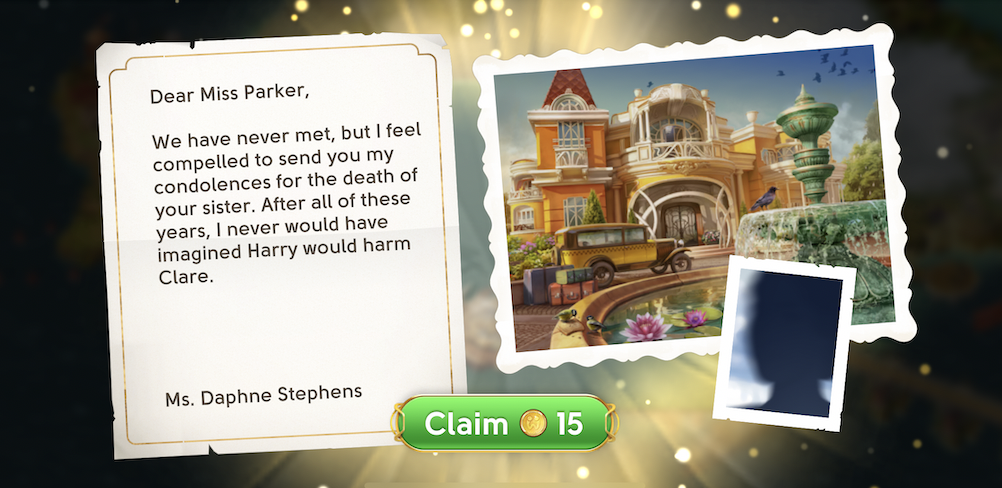
Push notifications are employed to ensure player retention and encourage continued engagement. They pop up in such cases as when one of your decorations has been finished, when you get some occasional rewards from the game, or when a milkman delivers your daily gift:


A game seems to track how often you open the app during the day. The more frequently you open the app, the higher the intensity of notifications you get.
9. Quick surveys
To better understand their audience and where they come from, Wooga conducts in-game surveys. Diamonds are used as a reward to motivate players to complete the survey:

10. LiveOps Calendar
To keep track of various activities, any game team needs a convenient and insightful calendar. Balancy calendar gives game teams a total control of their events, sales and a/b tests schedule. It also allows to compare the performance of different campaigns and quickly adjust the strategy on the go:
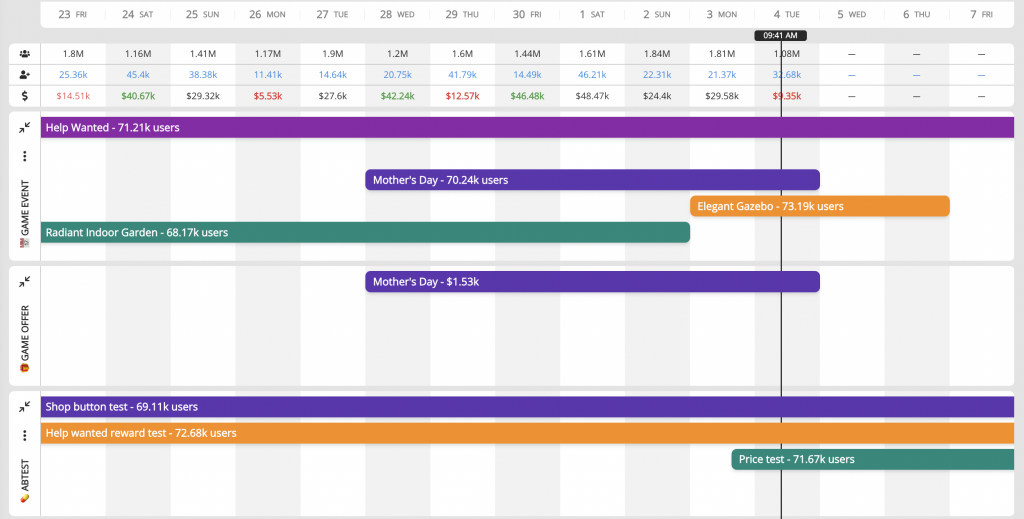
An example of how June’s Journey activities could look like in Balancy calendar.
Final Words
There are several key elements that make June’s Journey excel in captivating players: intriguing detective story, high-quality core gameplay, and the meta layer of garden decoration.
For the long term retention and monetization, the game seamlessly employes various LiveOps tactics, including time-limited events with unique decorations, daily rewards, special offers, tasks, and challenges.
It comes as no surprise that June’s Journey has so far enjoyed a long life cycle and got a dedicated audience worldwide.
If you want to run LiveOps like top market players, Balancy has solutions to cover all your needs. Explore our LiveOps platform to run personalized events and special offers to maximize the lifetime value of your game.